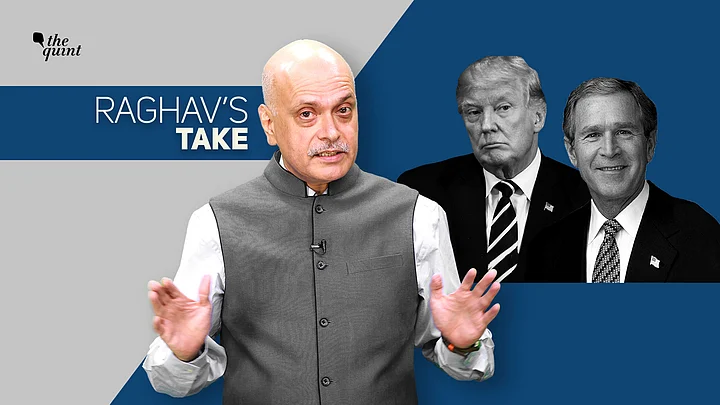It’s conventionally believed that Democrat POTUSes (like Kennedy, Carter, Clinton and Obama) were far more popular in India than the infrequent Republicans. But here was George W Bush Jr, hated across the world, but loved in India. Does it sound familiar, as Donald Trump gets ready to say kem chho (howdy)?
Bush’s ‘Engage India’ Campaign
Succeeding Clinton, George W. Bush Jr. was most determined to reach out to India. The US National Intelligence Council report, which mapped the world in 2020, concluded that “the arriviste powers—China, India and perhaps others such as Brazil and Indonesia—have the potential to render obsolete the old categories of East and West, North and South, aligned and non-aligned, developed and developing”.
Bush kicked off his “engage India” campaign in typical cowboy style: he “dropped in” unannounced at a meeting between the Indian external affairs minister, Jaswant Singh and Condoleeza Rice.
Bush took the Indian minister for a stroll in the Rose Garden, and then led him by the arm into the Oval office. Later that year, India did the politically unthinkable when it offered military bases to US troops preparing to strike Afghanistan after 9/11. While America declined that offer, the bonhomie between President Bush and Prime Minister Vajpayee was palpable in the months that followed.
Bush Gave India an Exemption from Nuclear Non Proliferation Treaty
Bush knew that he had to make a grand gesture, unprecedented in sweep and substance, to win over India. He and Vajpayee thought of ending India’s stubborn and splendid isolation on the NPT (Nuclear Non Proliferation Treaty). Now it was Bush’s turn to propose the unthinkable; going against allies like Japan, Germany and China, ignoring Pakistan’s fulminations, turning a deaf ear to shrieking ayatollahs, he gave an exemption to India from the treaty, the one and only such instance in world history!
By then, Vajpayee had lost a shock election, putting the soft-spoken Manmohan Singh in the hot seat. But Singh turned out to be hard as nails on this issue, even betting his job on the nuke deal. His quest was sharp: to convert India from a renegade to a legitimate “equal” on the world nuclear stage.
Bush and Manmohan Singh
Manmohan Singh also struck an unusual friendship with Bush. One was widely criticized as ‘India’s weakest PM’; the other seemed to love the epithet of ‘America’s war-mongering president’. There was even a personal twist in their relationship, which ought to have made Bush wary of Singh.
The Indian Prime Minister’s daughter was a vociferous, New York based human rights lawyer, forever in the forefront of anti-Bush campaigns.
But both men put aside personal issues. Bush visited India in March 2006, the first visit to India by a Republican president.
Bounding down the aircraft’s stepladder, Bush’s body language was effusive with Manmohan, who broke protocol to receive him at Delhi’s Indira Gandhi International Airport late at night. Turning to Condoleeza Rice, Bush was overheard saying: “I want this deal done.” Over the next few days, both men made visible displays of bonhomie, laughing, chatting, putting arms around each other’s shoulders.
President Bush concluded his 2006 visit with a nationally televised address from New Delhi’s historic Old Fort. He delivered a stellar eulogy to India and its rising potential in world affairs: “For many years, the United States and India were kept apart by the rivalries that divided the world. That is changed. The United States and India, separated by half the globe, are closer than ever before, and the partnership between our free nations has the power to transform the world.”
On a later visit to Washington, when President Bush’s popularity had nosedived and he was getting ready to quit the White House, Manmohan actually told him, in full media glare, that “all of India loves you”. He was politically castigated back home for that misplaced exuberance.
(At The Quint, we question everything. Play an active role in shaping our journalism by becoming a member today.)
